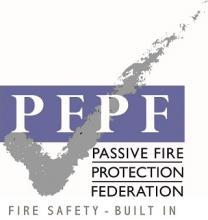PFPF praises fire safety initiatives
PFPF praises fire safety initiatives
Recognition of the need to improve fire safety compliance in the built environment is growing as fire industry initiatives gather pace, says the Passive Fire Protection Federation (PFPF).
As 2013 draws to a close, the PFPF is highlighting a number of initiatives which have served to raise the profile of fire safety in the built environment and offer assistance and advice to those responsible for designing, installing, maintaining and enforcing fire safety.
Earlier this year, PFPF Chairman Mike Wood expressed concern about low levels of compliance with fire legislation and called on the sector as a whole to work together to secure a safer built environment. While recognising that there is still a great deal of work to be done, Mr Wood believes that much progress has been made during 2013.
“The fire industry as a whole has the expertise and knowledge to advance fire safety best practice and, through the Fire Sector Federation, is now working together to identify and address issues that can lead to poor levels of protection,” says Mr Wood.
“Not only has the PFPF, been taking an active role in developing policy through its involvement in the Fire Sector Federation, but several PFPF member associations have themselves introduced successful initiatives to spread knowledge and develop understanding in the wider community.”
Each PFPF member is developing awareness initiatives in their individual sector areas. . The importance of ensuring the competence of those employed to install and maintain fire protection systems are central to current initiatives from members, including the Association for Specialist Fire Protection (ASFP), British Woodworking Federation (BWF), and the Glass and Glazing Federation (GGF).
The ASFP has developed a series of regional CPD seminars which offer an essential overview into all aspects of passive fire protection, its specification, installation, inspection and maintenance. Held in association with the BWF, GGF and local fire and rescue services, the first event took place in Manchester in September, with further events confirmed in Sunderland, Cardiff and London during 2014 and additional seminars in Birmingham, Scotland, Belfast and Dublin planned.
The ASFP has also developed a new national training course in passive fire protection aimed at improving the skills of contractors involved in the installation of remedial passive fire protection, as well as raising the knowledge base of those involved in the design, supply, inspection and maintenance of passive fire protection. The scheme, developed in collaboration with CITB and the Fire Protection Association is being piloted this November, before being rolled out during 2014.
In September, the BWF held Fire Door Safety Week. This inaugural event aimed to draw attention to the crucial role played by fire doors and to point out the dangers when fire doors are incorrectly specified, installed or maintained. The week was marked by a series of events and promotions supported by fire testing laboratories, trade associations and their members as well as local fire and rescue services, local authorities, landlords and other sleeping accommodation providers. It was hailed a huge success, reaching in excess of 6.5 million people and resulting in significant political support from the Fire Minister.
Following the success of Fire Door Safety Week, the BWF has also launched a new umbrella register of suitably qualified and UKAS-accredited fire door installers, an industry led initiative backed by the UK’s leading fire door experts. The scheme will be open to any installation company with certification from BM TRADA Certification, FIRAS or IFC and will be promoted to building owners in 2014.
Meanwhile, the GGF Fire Resistant Glazing Group has unveiled a new fire safety campaign in response to reported failings in the supply and construction chain to use properly tested and approved installations, as well as concerns about a general tendency to downgrade levels of fire safety, particularly through misguided engineering practices which erode fire safety margins. The GGF has been actively in dialogue with a number of MPs who have shown a high level of interest in its concerns. It has developed and promoted a code of five core principles which should be applied to all fire-resistant glass and glazing systems, and has received strong support for its campaign from other parts of the sector.
The PFPF is also offering its support for a proposal to create a National Fire Safe Register, for manufacturers and installers with proven competence. Mr Wood chaired a very well attended workshop at the Fire Sector Summit in October, at which delegates offered their unequivocal support for such a scheme. Commenting on the proposal, Mr Wood says:
“The industry must continue to seek out ways to provide simple advice to specifiers, as well as those responsible for the fire safety management under the Regulatory Reform (Fire Safety) Order.
“The PFPF believes it should be easy to identify a competent manufacturer, installer or maintainer and strongly advocates the use of third party certification of contractors for the installation and maintenance of passive fire protection products. We welcome the proposal to create a National Fire Safe Register and recommend it is investigated further.”
The outcomes from the Fire Sector Summit workshop were summarised by Mr Wood in a video and are to be taken to an ASFP Parliamentary Seminar, ‘Understanding Fire Safety in Buildings’, on the 4 December for further discussion. But what do you think? Register your opinion in the debate by taking part in the National Fire Safe Register Survey

